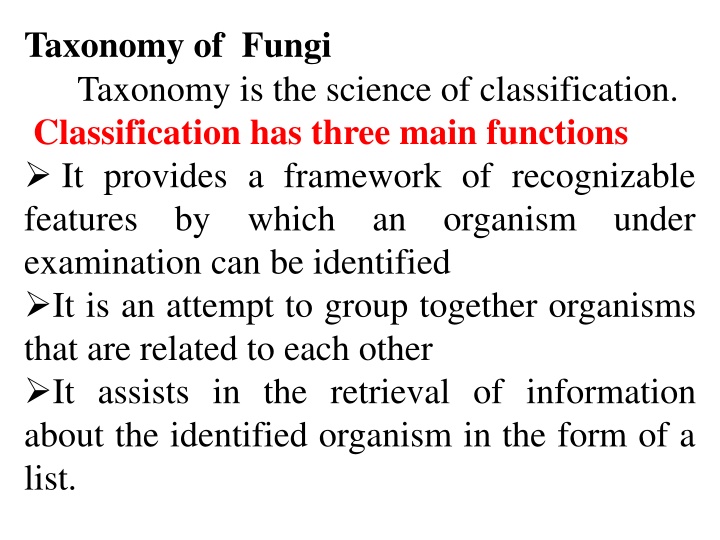
Fungal Taxonomy and Classification
Fungal taxonomy is the science of classification, aiming to identify, group related organisms, and aid in information retrieval. Traditional and modern methods, including ultrastructural and biochemical techniques, contribute to fungal classification. Key characters used include cell wall presence, chemical components, reproduction, and spores. The classification system for fungi includes Kingdom Mycetae (Fungi) and further divisions down to species level.
Download Presentation

Please find below an Image/Link to download the presentation.
The content on the website is provided AS IS for your information and personal use only. It may not be sold, licensed, or shared on other websites without obtaining consent from the author. If you encounter any issues during the download, it is possible that the publisher has removed the file from their server.
You are allowed to download the files provided on this website for personal or commercial use, subject to the condition that they are used lawfully. All files are the property of their respective owners.
The content on the website is provided AS IS for your information and personal use only. It may not be sold, licensed, or shared on other websites without obtaining consent from the author.
E N D
Presentation Transcript
Taxonomy of Fungi Taxonomy is the science of classification. Classification has three main functions It provides a framework of recognizable features by which an organism under examination can be identified It is an attempt to group together organisms that are related to each other It assists in the retrieval of information about the identified organism in the form of a list.
Traditional and modern taxonomic methods Early philosophers classified matter into three Kingdoms: Animal, Vegetable, and Mineral. Fungi were placed in the Vegetable Kingdom because of certain similarities to plants such as their lack of mobility, absorptive nutrition, and reproduction by spores.
Useful ultrastructural details, provided by transmission electron microscopy TEM, concern the appearance of mitochondria, properties of the septal pore, details of the cell wall during spore formation or germination, or the arrangement of secretory vesicles in the apex of growing hyphae.
Biochemical methods have also made valuable contributions, especially in characterizing higher taxonomic levels. Examples include the chemical composition of the cell wall, alternative pathways of lysine biosynthesis, the occurrence of pigments and the types and amounts of sugars.
Generally, the characters used in fungal classification are: Cell wall Cell wall present: true fungi Cell wall absent: slime molds Chemical components of cell wall Somatic phase Reproduction Structure formed by fungi Spores: size, color, shape, number of cell and type of spores.
The classification system in fungi at this edition started with kingdom and end with species as follows: Kingdom: Mycetae (Fungi) Division: Mycota Subdivision: Mycotina Class: Mycetes Subclass: Mycetidae Order: ales Family: aceae Genus and Species: There is no special ends
Process of Classification Identification The relationships among other fungi and living organisms Nomenclature The Scientists of fungal taxonomy: Whittaker s 1969 Classification: divided the living organisms in to five kingdoms according to cellular characterizations and he placed all eukaryotes, heterotrophs and have cell wall organisms in kingdom fungi
Alexopoulos et al. : in his book "Introductory Mycology" 1979 , 3rded. He put the fungi in kingdom "Mycetae" and divided them into three divisions as follow: Kingdom: Mycetae Division1: Gymnomycota Division2: Mastigomycota Division3:Amastigomycota
Alexopoulos et al. : in his book "Introductory Mycology" 1996 ,4thed. He put the fungi in three kingdoms and divided them in to phylum as follows: Kingdom1: Protista Kingdom2: straminipila Kingdom3: true fungi Kendrick in his book " fifth kingdom"(2002) put the fungi in three groups as follows: 1: Pseudo Fungi: Included Slime Molds 2:Simple Fungi 3:True Fungi
Minnesota University classification in USA(2005): divided fungi into two large super kingdoms as follows: Super kingdom Eumycota : included kingdom Eumycota (Phylum: Chytridiomycota, Zygomycota, Ascomycota, Basidiomycota and Deurtomycota). Super kingdom Psudomycota: included a. kingdom Mycetozon (phylum: Myxomycota) b. kingdom protozoa (phylum: Plasmodiophoromycota) c. kingdom Straminipila (phylum: Oomycota and phylum: Hyphochytriomycota)
The classification scheme adopted in book of Webster and Weber (Introduction to Fungi, 2007 3rded. ) , showing mainly those groups treated in some detail. Kingdom1: Protozoa Phylum1 :Myxomycota
Kingdom2: Straminipila Phylum1 :Hyphochytriomycota Phylum2:Labyrinthulomycota Phylum3:Oomycota Kingdom3: Fungi (Eumycota) Phylum1 : Chytridiomycota Phylum2 : Zygomycota Phylum3 : Basidiomycota Phylum 4: Ascomycota Phylum 5: Anamorphic fungi
Division 1: Gymnomycota Class 1: Myxomycetes One founders of mycology considered the slime molds animals and called them Mycotozoa-; because the vegetative phase is like- plasmodium. What is plasmodium? It is a mass of protoplasm, de limited only by a thin plasma membrane and a gelatinous sheath. The plasmodium does not have a definite size or shape. The protoplast is fluid in some portions and gelatinous in others veins- .
Types of reproductive organs (sporophores) in Myxomycetes: 1- Sporangium: This sporangium either bearing on stalk or stalkless sessile-, each sporangium has a peridium of its own. There may also a thin , cellophane-like base, the hypothallus, and there are spores and capilitium inside sporangium. Ex: Physarum.
2- Plasmodiocarp: Is similar to a stalk less sporangium. In the formation of plasmodiocarp, the protoplasm concentrates around some of the main veins of the plasmodium and secreting a membrane around itself Ex: Trichia.
3-Aethalia: A group of sporangia that have not separated into individual units. In some aethalia the wall of the individual sporangia are quite evident, in other they are difficult to see Ex: Lycogala
Classification of Class 1; Myxomycetes: The class myxomycetes classified into two subclasses according to the position of the spores in relation to the fruiting body. Subclass 1: Ceratiomyxomycetidae In this subclass spores born outside ( no fruiting body ) Order: Ceratiomyxales Genus: Ceratiomyxa This genus called exospores, there is no sporangium.
Subclass 2: Myxogastromycetidae In this subclass spores born inside sporangia ( fruiting body ) Endospores-. This subclass classified into 4 orders according to: 1- The color of sopres. 2- Presences or absence of capilitium. 3- Presence or absences of lime. Order 1: Liceales: - Spores in mass are pallid or brightly colored. - The capilitium and columella are lacking. - Pseudocapilitium is often present. - Ex:- Lycogala
Order 2: Trichiales - Sporangium is large, stalked or sessile. -Columella is lacking. - Sporangium contains spores and capilitium. -Ex: Arcyria. Order 3: Stemonitales: -Spores are dark or black in color. - Columella is presence. -Lime is absences. -Ex: Stemonitis. Order 4: Physarales - The same characteristics of order Stemonitales except lime is presence. - Ex: Physarum



